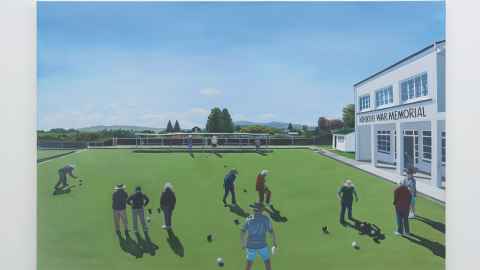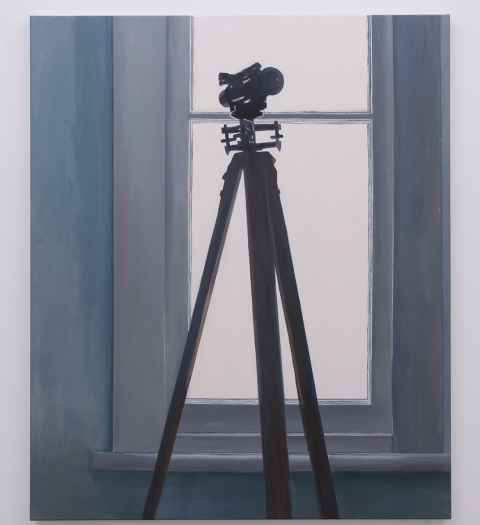The University of Auckland's Art Collection of around 2,000 artworks is well-regarded for including work by many of New Zealand's best-known and loved artists.

Two paintings have been welcomed into the University of Auckland Art Collection recently: Land Survey (2021) and Whakakotahi (2022), both by contemporary painter Hiria Anderson (Rereahu, Ngāti Maniapoto, Ngāti Apakura).
Hiria was brought up in Ōtorohanga, a small town in Waikato on the banks of the Waipa River, where she still lives and works today.
Her detailed paintings are created in her studio on Tūrongo Street, where her grandparents lived, and where they raised their children and granddaughter. Hiria's paintings are inspired by her life in Ōtorohanga on the whānau marae, and often incorporate her grandparents' skilled work in traditional whakairo (carving) and raranga (weaving).
Hiria frames her paintings first through photographs taken on her phone that capture pieces of her world and community. She uses photography as a tool for observing the compositions, which then become slow-moving artworks through her process of rendering them in oil paint. In depicting these slice-of-life scenes, Hiria is giving viewers an intimate insight into the everyday life of her community, while also creating artworks that portray the politics and nuances of Māori culture in our contemporary world.
A suite of these intimate works was included in the Toi Tū Toi Ora: Contemporary Māori Art exhibition at Auckland Art Gallery Toi o Tāmaki in 2021, curated by alumnus Nigel Borell and featuring more than 300 artworks by 110 Māori artists. The subjects ranged from a stack of pudding plates in the pā kitchen, to a close-up detail of a whakairo at the whānau marae. Art writer Lucinda Bennett says of Huria's works, "In depicting the everyday lives of her community, these paintings interrogate the history of representation of Māori in European art, gently shifting the viewpoint from outside looking in, to inside, looking at one another."
Hiria's two paintings now in the University's Art Collection are at a larger scale than many of her earlier works, marking a shift in her practice that she continues to explore. The first, Land Survey (2021), is from her solo-exhibition Taonga (Tim Melville Gallery, 2021), and captures a telescope in front of a window, seemingly poised for a viewer to peer through at the landscape beyond.
When creating this work, Hiria had recently joined the Ōtorohanga Museum Committee. She used her paintings to explore her questions about which objects become taonga, and how the audience reacts to being in the presence of 'museum objects'.
In depicting the everyday lives of her community, these paintings interrogate the history of representation of Māori in European art, gently shifting the viewpoint from outside looking in, to inside, looking at one another.
Art writer Lucinda Bennett, speaking of Hiria Anderson

Of Land Survey, Hiria posed the question, "If we visit a museum and see a land-surveying instrument, in a region where Māori were subject to vast land confiscation, what should we think? Who decides?"
A similar theme is explored in Whakakotahi (2022), which depicts the relatively familiar scene of a group of bowls players on the Kihikihi War Memorial bowling green. In slowly rendering this particular outlook, the artist captures Parawera and Rangiowhia in the background; the latter being the site of a horrific war crime perpetuated by the Crown against Waikato Māori. The painting is a sobering visualisation of local colonial history, emphasising the importance of understanding such complexities.
In the foreground however, Hiria incorporates both Māori and Pākehā figures from the community, playing bowls together. Encapsulating a fitting and intentional sentiment, she has titled the work Whakakotahi; understood as a call to unite and unify, in te reo Māori.
The University's Art Collection comprises close to 2,000 artworks and is well-regarded for including work by many of New Zealand's best-known and most loved artists. The collection is a valuable cultural asset shared across campuses and luckily for people in Auckland, it's permanently on display.
By Madeleine Gifford






